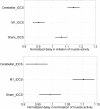Facilitating myoelectric-control with transcranial direct current stimulation: a preliminary study in healthy humans
- PMID: 24507410
- PMCID: PMC3931480
- DOI: 10.1186/1743-0003-11-13
Facilitating myoelectric-control with transcranial direct current stimulation: a preliminary study in healthy humans
Abstract
Background: Functional Electrical Stimulation (FES) can electrically activate paretic muscles to assist movement for post-stroke neurorehabilitation. Here, sensory-motor integration may be facilitated by triggering FES with residual electromyographic (EMG) activity. However, muscle activity following stroke often suffers from delays in initiation and termination which may be alleviated with an adjuvant treatment at the central nervous system (CNS) level with transcranial direct current stimulation (tDCS) thereby facilitating re-learning and retaining of normative muscle activation patterns.
Methods: This study on 12 healthy volunteers was conducted to investigate the effects of anodal tDCS of the primary motor cortex (M1) and cerebellum on latencies during isometric contraction of tibialis anterior (TA) muscle for myoelectric visual pursuit with quick initiation/termination of muscle activation i.e. 'ballistic EMG control' as well as modulation of EMG for 'proportional EMG control'.
Results: The normalized delay in initiation and termination of muscle activity during post-intervention 'ballistic EMG control' trials showed a significant main effect of the anodal tDCS target: cerebellar, M1, sham (F(2) = 2.33, p < 0.1), and interaction effect between tDCS target and step-response type: initiation/termination of muscle activation (F(2) = 62.75, p < 0.001), but no significant effect for the step-response type (F(1) = 0.03, p = 0.87). The post-intervention population marginal means during 'ballistic EMG control' showed two important findings at 95% confidence interval (critical values from Scheffe's S procedure): 1. Offline cerebellar anodal tDCS increased the delay in initiation of TA contraction while M1 anodal tDCS decreased the same when compared to sham tDCS, 2. Offline M1 anodal tDCS increased the delay in termination of TA contraction when compared to cerebellar anodal tDCS or sham tDCS. Moreover, online cerebellar anodal tDCS decreased the learning rate during 'proportional EMG control' when compared to M1 anodal and sham tDCS.
Conclusions: The preliminary results from healthy subjects showed specific, and at least partially antagonistic effects, of M1 and cerebellar anodal tDCS on motor performance during myoelectric control. These results are encouraging, but further studies are necessary to better define how tDCS over particular regions of the cerebellum may facilitate learning of myoelectric control for brain machine interfaces.
Figures






Similar articles
-
Polarity independent effects of cerebellar tDCS on short term ankle visuomotor learning.Brain Stimul. 2013 Nov;6(6):966-8. doi: 10.1016/j.brs.2013.04.008. Epub 2013 May 17. Brain Stimul. 2013. PMID: 23711765
-
Transcranial direct-current stimulation combined with attention increases cortical excitability and improves motor learning in healthy volunteers.J Neuroeng Rehabil. 2020 Feb 19;17(1):23. doi: 10.1186/s12984-020-00665-7. J Neuroeng Rehabil. 2020. PMID: 32075667 Free PMC article.
-
Anodal transcranial direct current stimulation alters elbow flexor muscle recruitment strategies.Brain Stimul. 2014 May-Jun;7(3):443-50. doi: 10.1016/j.brs.2014.01.057. Epub 2014 Jan 29. Brain Stimul. 2014. PMID: 24582369
-
Non-invasive cerebellar stimulation--a consensus paper.Cerebellum. 2014 Feb;13(1):121-38. doi: 10.1007/s12311-013-0514-7. Cerebellum. 2014. PMID: 23943521
-
Targeting the Human Cerebellum with Transcranial Direct Current Stimulation to Modulate Behavior: a Meta-Analysis.Cerebellum. 2018 Apr;17(2):228-236. doi: 10.1007/s12311-017-0877-2. Cerebellum. 2018. PMID: 28786014 Free PMC article. Review.
Cited by
-
Transcranial cerebellar direct current stimulation and transcutaneous spinal cord direct current stimulation as innovative tools for neuroscientists.J Physiol. 2014 Aug 15;592(16):3345-69. doi: 10.1113/jphysiol.2013.270280. Epub 2014 Jun 6. J Physiol. 2014. PMID: 24907311 Free PMC article. Review.
-
Immediate effect of transcranial direct current stimulation combined with functional electrical stimulation on activity of the tibialis anterior muscle and balance of individuals with hemiparesis stemming from a stroke.J Phys Ther Sci. 2017 Dec;29(12):2138-2146. doi: 10.1589/jpts.29.2138. Epub 2017 Dec 7. J Phys Ther Sci. 2017. PMID: 29643591 Free PMC article.
-
Systems Analysis of Human Visuo-Myoelectric Control Facilitated by Anodal Transcranial Direct Current Stimulation in Healthy Humans.Front Neurosci. 2018 Apr 30;12:278. doi: 10.3389/fnins.2018.00278. eCollection 2018. Front Neurosci. 2018. PMID: 29760645 Free PMC article.
-
The Effect of Cerebellar tDCS on Sequential Motor Response Selection.Cerebellum. 2019 Aug;18(4):738-749. doi: 10.1007/s12311-019-01029-1. Cerebellum. 2019. PMID: 31062282 Free PMC article.
-
Halo Sport Transcranial Direct Current Stimulation Improved Muscular Endurance Performance and Neuromuscular Efficiency During an Isometric Submaximal Fatiguing Elbow Flexion Task.Front Hum Neurosci. 2022 Feb 17;16:758891. doi: 10.3389/fnhum.2022.758891. eCollection 2022. Front Hum Neurosci. 2022. PMID: 35250511 Free PMC article.
References
-
- Graupe D, Kohn K. Functional electrical stimulation for ambulation by paraplegics. University of Michigan, USA: Krieger Publishing Company; 1994. pp. 113–115.
-
- Kralj A, Bajd T. Functional Electrical Stimulation: Standing and Walking After Spinal Cord Injury. Boca Raton, USA: CRC Press; 1989. pp. 123–177.
-
- Chae J, Quinn A, El-Hayek K, Santing J, Berezovski R, Harley M. Delay in initiation and termination of tibialis anterior contraction in lower-limb hemiparesis: relationship to lower-limb motor impairment and mobility. Arch Phys Med Rehabil. 2006;87(9):1230–1234. doi: 10.1016/j.apmr.2006.05.007. - DOI - PubMed
Publication types
MeSH terms
LinkOut - more resources
Full Text Sources
Other Literature Sources
Miscellaneous

